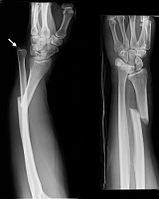
Photo from wikipedia
Introduction Delayed reduction of the hip in femoral head fracture dislocation increases the risk of osteonecrosis and adversely affects the functional outcome. Materials and Methods This retrospective study was designed… Click to show full abstract
Introduction Delayed reduction of the hip in femoral head fracture dislocation increases the risk of osteonecrosis and adversely affects the functional outcome. Materials and Methods This retrospective study was designed to evaluate the outcome and complications of 138 patients with femoral head fracture dislocation treated by a single surgeon over a period of 22 years. Only seven patients presented within 24 h of injury and remaining all presented late. The hip joints could be reduced by closed manoeuvre in 105 patients, and 33 patients needed open reduction. The patients were managed conservatively or surgically. The mean follow-up period was 3.57 years (1-18 years). Results There were 119 males and 19 females. The mean age was 35.71 years (range, 18-70 years). Forty-two patients were managed conservatively, and 96 patients needed surgical treatment. The Kocher-Langenbeck approach was used in 40 patients, the trochanteric flip osteotomy in 14 patients, the Smith-Peterson approach in 31 patients, and the Watson-Jones approach in one patient. The femoral head fragment was fixed in 47.82% patients and excised in 11.59% patients. Primary total hip replacement (THR) was performed in 7.24% of patients through the posterior approach. 24.63% of patients developed complications with 14.49% of hip osteonecrosis, 2.89% posttraumatic osteoarthritis and 2.17% femoral head resorption. 55% of patients who developed osteonecrosis were operated through the posterior approach. Secondary procedures were needed in 14.48% of patients. The clinical outcome, as evaluated using the modified Harris Hip Score, was good to excellent in 52.89% of patients and poor to fair in 47.11% of patients. Conclusion The incidences of osteonecrosis and secondary procedures are increased in delayed and neglected femoral head fracture dislocation. Osteonecrosis is commonly seen in Brumback 2A injuries and posterior-based approaches. All Brumback 3B fractures in such delayed cases should be treated with THR. Osteosynthesis or conservative treatment should be reserved for other types of injuries. A careful selection of treatment plan in such delayed cases can result in a comparable functional outcome as reported in the literature.
Journal Title: Indian journal of orthopaedics
Year Published: 2021
Link to full text (if available)
Share on Social Media: Sign Up to like & get
recommendations!